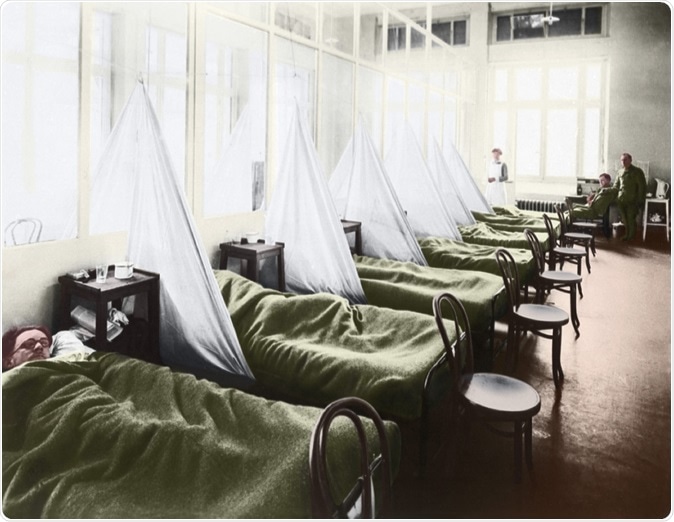An archive of letters written by those who survived the Spanish flu pandemic at the start of the last century shows what it was actually like to live during that time. The Spanish flu pandemic killed over 250,000 people in Britain alone and worldwide it wiped out a population of over 100 million.
Hannah Mawdsley, a PhD researcher at Queen Mary University of London, was looking at the documents at the Imperial War Museum when she found these letters. She says the letters are a “precious window into the human experience of the pandemic.” The letters came to the museum from historian and journalist Richard Collier who collected them in the 1970s from nearly 1,700 survivors of the pandemic. The letters were then analyzed by the BBC England data unit who also looked at the medical officers' records for English districts. These records were housed in the Wellcome Library.

An influenza ward at the U S Army Camp Hospital in Aix-les-Bains France during the Spanish Flu epidemic of 1918-19, 1918 photograph with digital color. Image Credit: Everett Historical / Shutterstock
A nine year old girl from Coventry for example wrote to Mr Collier in the 1970s about how she lost both her 35-year-old mother and seven-year-old sister within two days. She wrote, “It caused quite a sensation having to have a double funeral on November 11th 1918, which was the very day the First World War ended... I can remember very well when the cortege was on its way to the church. Bells, hooters and all sounds of celebration were raving but how silent people stood who realised it was our funeral. It really was a terrible time, not knowing who we were going to lose next.”
The soldiers were returning home after the war ended and it then that the Spanish flu entered Britain. Ms Mawdsley says there were horror stories of the war from the soldiers who had survived and as they returned they found that their wives had died of the flu. “There was all this celebration, joy and relief at the end of the war that collides with death and grief,” she said.
One of the letters is from a young son of a Baptist minister in Leicester who said his father was conducting funerals from “dawn to dusk” and slept at the cemetery chapel because he did not want to take the virus home to his family of eight children and a wife. In 1918 in Leicester there were more deaths than births but the family of the Baptist Minister survived the pandemic. The man wrote to Collier on 19 May 1973, “The funeral corteges followed each other through the town... Often there was more than one coffin in a hearse. Graves were used to bury more than one person, especially when more than one of a household were victims at the same time.”
According to Ms Mawdsley, some of the letters spoke of the symptoms of the flu. She said that a letter describes a “heliotrope cyanosis” which was a “creeping blue which started in your fingertips, tips of your ears and nose and lips but you could go completely black,” she said. After death the dead body turned completely black she said and this must have been traumatizing for the family. A man wrote to Collier on 16 May 1973, “The undertakers couldn't make the coffins quick enough, let alone polish them... The bodies changed colour so quickly after death they had to be screwed down to await burial. The gravediggers worked from dawn to dusk seven days a week to cope. The smell of those deaths was indescribable.”
The letters also talk about the psychosis that Spanish flu caused to some individuals which prompted murders and suicides. The courts called these “delirium during influenza.” A man who was in the RAF at Blandford Camp in Dorset wrote to Collier, “A small wood below the camp was called 'suicides wood' because of the number of men, who had flu, committing suicide there. The flu seemed to leave people with disturbed minds.”
Ms Mawdsley said viral diseases were not understood well at the time and there was no cure. “'Cures' ranged from standard camphor and quinine to alcohol - whisky in particular was sworn as the cure,” she said. “But some more extreme cures like creosote and strychnine were used. Basically, people were so desperate they would try anything,” she said. She said that the only thing that helped was good nursing and a “big call out for volunteer nurses at this time as so many had been shipped off to the Western Front.”
The Wellcome Library says that one fourth of the British population was ill with the Spanish flu during the pandemic which killed 228,000 people. The worst hit places were Leicester, Coventry Felixstowe and Malmesbury. In 2016 people dying from flu in England and Wales was 430 as a contrast.